Seeley Breezair EXT User manual

(English)
INSTALLATION & OPERATION MANUAL
EXT Evaporative Coolers
Original English Instructions
ILL1672-A

i |
CONTENTS
IMPORTANT SAFETY INSTRUCTIONS
Read And Save These Instructions For Future Reference. 1
Warnings 1
Employer And Employee Responsibilities 1
Installer And Maintenance Contractors - Risk Assessment 1
Some Points To Consider 1
Other Important Requirements 1
QUICK GUIDE 2
INSTALLATION
Pack Out Kit Contents 4
Cooler Location 4
Access For Servicing And Maintenance 4
Installing The Roof Jack 5
Conveying The Cooler To The Roof 5
Mounting The Cooler 5
Securing The Leg Supports 6
Weatherseal And Latch 6
Water Requirements 7
Water Connections 7
Overow And Bleed O Feature 7
Setting The Water Level 8
Electrical Requirements 9
Wiring Diagrams 9
Motor Power (Amps) 11
Pulley Adjustment 11
Belt Tension 12
Resetting The Pump Circuit Breaker 12
Bleed O 13
COOLER OPERATION
Using Your Cooler 14
Start Up 14
MAINTENANCE
Health Regulations 15
Access For Servicing And Maintenance 15
Residential Maintenance Schedule 16
Requirements For All Coolers (Every 2 Years) 16
Additional Requirements For Coolers With Bleed System 18
Commercial / Industrial Maintenance Schedule 19
Requirements For All Coolers (Every 3 Months Or Twice Per Year) 19
Additional Requirements For High Operation Hours (Every Year) 20
Commercial Service Record 21
COMMISSIONING
Setting The Water Level 22
Testing The Pump 22
Retting The Pad Frames 22
Commissioning The Cooler 23
Commissioning Completion Checklist 23
TROUBLE SHOOTING 24
EXPLODED VIEW 25
WARNING! Failure to install and commission the product in compliance with these instructions, or failure to do
the job properly and competently, may void the customer’s warranty. Further, it could expose the Installer and/or
the Retailer to serious liability.

INSTALL AND OPERATION MANUAL EXT |1
IMPORTANT SAFETY INSTRUCTIONS
READ AND SAVE THESE INSTRUCTIONS FOR
FUTURE REFERENCE.
Means for all pole disconnection must be incorporated in the
xed wiring in accordance with the wiring rules.
If the supply cord is damaged, it must be replaced by the
manufacturer, its service agent or similarly qualied persons in
order to avoid a hazard.
The following specications for the cooler water supply are
required:
Min Water Pressure: 15psi (100kPa)
Max Water Pressure: 115psi (800kPa)
New hose sets supplied with the appliance are to be used and
old hose-sets should not be re-used.
WARNINGS
TO REDUCE THE RISK OF FIRE, ELECTRIC SHOCK, OR
INJURY TO PERSONS, OBSERVE THE FOLLOWING:
1.Installation work and electrical wiring must be done by
qualied person(s) in accordance with all applicable codes
and standards, including re-rated construction.
2. When cutting or drilling into wall or ceiling, do not damage
electrical wiring and other hidden utilities.
3. Ducted fans must always be vented to the outdoors.
4.Do not use this fan with any solid-state speed control device.
EMPLOYER AND EMPLOYEE RESPONSIBILITIES
The installation and maintenance of evaporative coolers at
height has the potential to create Occupational Health and
Safety issues for those involved. Installers are advised to
ensure they are familiar with the relevant State and Federal
legislation, such as Acts, Regulations, approved Codes of
Practice and National Standards, which oer practical guidance
on these health and safety issues. Compliance with these
regulations will require appropriate work practices, equipment,
training and qualications of workers.
Seeley International provides the following information as a
guide to contractors and employees to assist in minimising risk
whilst working at height.
INSTALLER AND MAINTENANCE CONTRACTORS -
RISK ASSESSMENT
A risk assessment of all hazardous tasks is required under
legislation. A risk assessment is an essential element that
should be conducted before the commencement of work, to
identify and eliminate the risk of falls or to minimise these risks
by implementing control measures. There is no need for this to
be a complicated process, it just is a matter of looking at the job
to be done and considering what action(s) are necessary so the
person doing the job does not injure themselves.
This should be considered in terms of:
• What are the chances of an incident happening?
• What could the possible consequence be?
• What can you do to reduce, or better still, completely get rid of
the risk?
SOME POINTS TO CONSIDER
• What is the best and safest access to the roof and working
areas?
• If a worker is alone, who knows they are there and if they get
into diculty, how can they summon help? (Call someone on
the ground? Mobile phone? Etc.)
• What condition is the roof in? Should the trusses, underside
or surface be checked?
• Does the worker have appropriate foot wear? (Flat sole jogger
type is advisable.)
• Are all power cables / extension leads safe and appropriately
rated?
• Are all ladders, tools and equipment suitable in good
condition?
• Where ladders are to be used, is there a rm, stable base for
them to stand on? Can they be tied or secured in some way
at the top? Is the top of the ladder clear of electricity supply
cables?
• Is there a roof anchor to attach a harness and lanyard to? If
so, instruction should be issued for the use of an approved
harness or only suitably trained people used.
• Are all tools and materials being used, prevented from
slipping and falling onto a person at ground level? Is the area
below the work area suitably protected to prevent persons
walking in this area?
• Does the work schedule take into account weather conditions,
allowing for work to be suspended in high winds, thunder
storms/lightning or other types of weather giving wet, slippery
surfaces?
• Is there an on-going safety check system of harnesses,
ropes, ladders and access/lifting equipment and where they
exist on roofs, anchor points before the commencement of
work?
• Is there a system which prevents employees from working
on roofs if they are unwell or under the inuence of drugs or
alcohol?
• Are there any special conditions to consider i.e. excessive
roof pitch, limited ground area, fragile roof, electrical power
lines?
OTHER IMPORTANT REQUIREMENTS
• Never force parts to t because all parts are designed to t
together easily without undue force.
• Never drill holes in the tank (reservoir) of the cooler.
• Check the proposed cooler location, to ensure that it is
structurally capable of supporting the weight of the cooler, or
provide an adequate alternate load bearing structure.
Ensure the installation complies with all local and national
regulations with regards to electrical, plumbing and bushre/
wildre construction requirements.

2 |
STEP 13
ELECTRICAL REQUIREMENTS
page 9
STEP 15
CHECK MOTOR AMPS
STEP 9
WATER REQUIREMENTS
Installation of the cooler water supply
must conform to local plumbing rules,
regulations and standards.
page 11
page 7
STEP 7
SECURING LEG SUPPORTS
The telescopic leg supports (with feet
attached) slide up and down inside the
four corner posts.
STEP 14
WIRING DIAGRAMS
page 9
ILL959-B
DIAGRAMA DE CABLEADO EN EL SITIO
MóDULO ELECTRóNICO
NEGRO/MARRóN
VERDE/AMARILLO
BLANCO/AZUL
GABINETE DEL SISTEMA
DE ENFRIAMIENTO
INTERRUPTOR DE
DESCONEXIóN OMNIPOLAR
SUMINISTRADO POR EL
INSTALADOR
CAJA DE EMPALMES
verde/amarillo
FUENTE DE ALIMENTACIóN
PRINCIPAL
L2(EE.UU.)
N(EUROPA)
HIGH
FIELD WIRING HIGH
VENT
OFF
LOW LOW
COOL
GROUND/EARTH
TERMINAL BOX
WALL
CONTROL
HOT WIRE/LINE VOLTAGE
USAEAWIRING DIAGRAM - 2 SPEED
SINGLE PHASE 115V (LINE VOLTAGE
WIRED TO COOLER)
COMMON/NEUTRAL
MOTOR CURRENT (AMP)
TEST POINT
FAN
CONTROL
PUMP
CONTROL
PUMP
HOT WIRE TO WALL CONTROL
GROUND/EARTH
COMMON/NEUTRAL
FACTORYWIRING (DO NOT DISTURB)
ILL1026-A
ALTO
CABLEADO DEL CAMPO
ALTO
VENTILACIÓN
FRESCO
APAG
BAJA
BAJA
MASA/TIERRA
CAJA DE EMPALME
CONTROL
DE LA
PARED
L NEA CON CORRIENTE
Í
USA EA -DIAGRAMAS DE CONEXIONES ELECTRICAS DOS VELOCIDADES
115VMONOFASICO
(LÍNEA DE SUMINISTRO CONECTADA PRIMERO AL ENFRIADOR)
COM N/NEUTRALÓ
PUNTO DE PRUEBA ACTUAL DEL MOTOR
PUNTO DE PRUEBA ACTUAL DEL MOTOR
AVIENTE
EL CONTROL
CONTROL
DE LA
BOMBA
BOMBA
HILO CALIENTE AL CONTROL DE LA PARED
MASA/TIERRA
COM N/NEUTRAL
Ó
NO INTERFIERA CON LAS CONEXIONES ELÉCTRICAS DE FÁBRICA.
ILL1026-A
OPCIÓN 1 DEL CABLEADO
page 6
STEP 1
SAFETY
Read & understand the safety section.
STEP 8
WEATHERSEAL
Check operation of the Weatherseal
STEP 2
COOLER LOCATION
Check cooler location. Consider
regulations. Discuss with customer.
STEP 3
INSTALL ROOFJACK
Install 24G metal roof jack and
seal before mounting.
page 1
page 6
page 4
ILL3363-A
page 5
STEP 22
FINAL CHECK
Test & complete the commissioning
checklist at the end of this document.
STEP 23
CLEAN UP
Clean up the site!
STEP 24
CUSTOMER HANDOVER
Show customer how to operate
the cooler. Explain maintenance
requirements.
page 16 page 16 page 16
QUICK GUIDE

INSTALL AND OPERATION MANUAL EXT |3
FLOATVALVE
ADJUSTMENT
DO NOT BEND
FLOAT ARM
WATER INLET
WITH BRASS FITTINGS
TO 1/4" COPPER TUBING
ILL399-E
FLOATVALVE
NIPPLE
1/2” N.P.T
STEP 10
MAINS WATER CONNECTION
A permanent water supply is required
to be connected to the water inlet tting
assembly that is supplied with the cooler.
STEP 11
OVERFLOW & BLEED OFF FEATURE
A special "bleed-o"
tting is supplied with
the cooler.
It has a
3-fold function: it acts
as an overow,
a drain and
a bleed-o.
page 7 page 7
ILL579-E
FILTER PAD
WATER BLEED
OVERFLOW
“O” RING
“O” RING
BUSH
TANK
PLUGS
TANK NUT
DRAIN ADAPTOR
DRAIN NUT
BLEED FUNNEL
(Remove to drain)
ILL579-E
ALMOHODILLA
ENFRIADORA
DESHOGO DE AGUA
DESBORDAMIENTO
DISPOSITIVO
DE DESAHOGO
JUNTATORICA
JUNTATORICA
BUJE CON
ROSCA
TUERCA
ADAPTADOR
CONTRATUERCA
TANQUE
TAPONES
Spanish
STEP 19
REFIT PAD FRAMES
Ret the pad frames before testing the
pump.
page 15
2
3
1
STEP 14
SET MOTOR AMPS
page 10
STEP 15
ADJUST BELT TENSION
page 10
STEP 6
MOUNT COOLER
Mount cooler to the dropper.
Check tank (reservoir) is level.
STEP 12
SET THE WATER LEVEL
page 5
page 8
STEP 4
LEVEL ROOF JACK
Position, level, secure and seal the roof
jack.
STEP 5
CONVEY COOLER
Convey the cooler to the roof.
Note! Always use 2 people when
handling manually.
page 5 page 5
ILL922-B
QUICK GUIDE
WATER LEVEL
WATER LEVEL
FLOAT
VALVE
BASE
ILL820-B
FLOAT
VALVE
BODY 1/4"
Table of contents
Other Seeley Accessories manuals
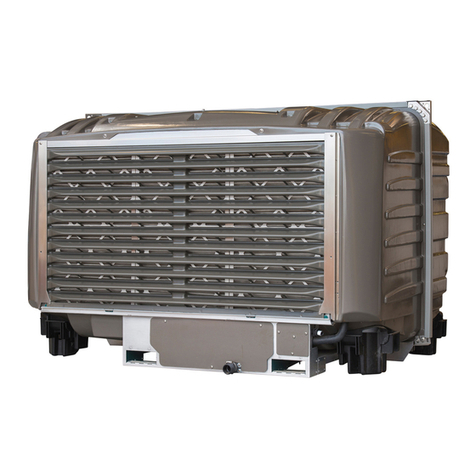
Seeley
Seeley Climate Wizard CW-P15 Owner's manual
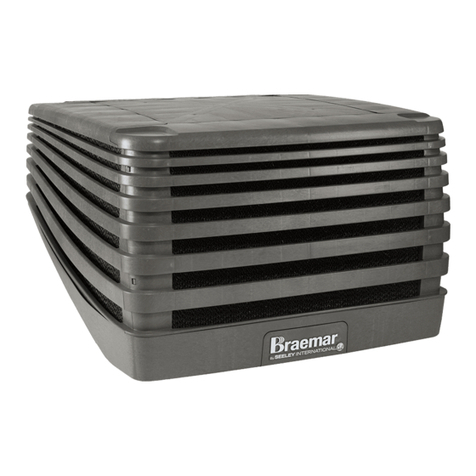
Seeley
Seeley LCQ User manual
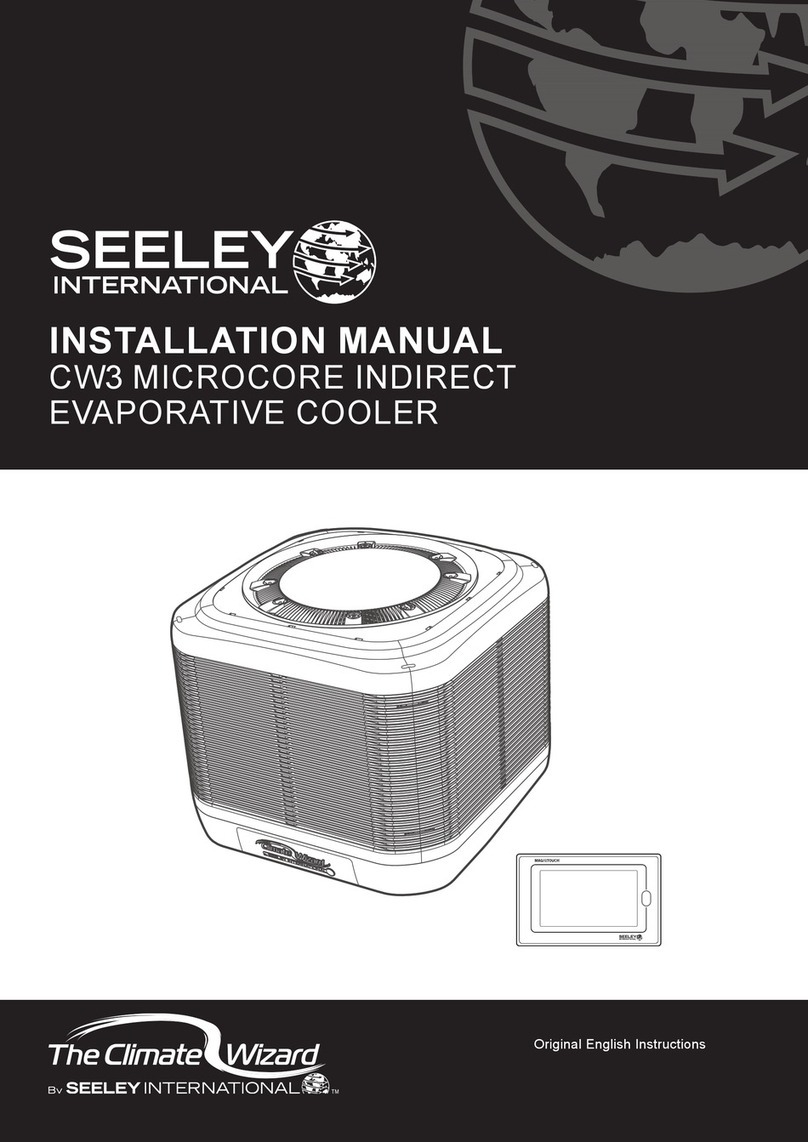
Seeley
Seeley CW3 User manual
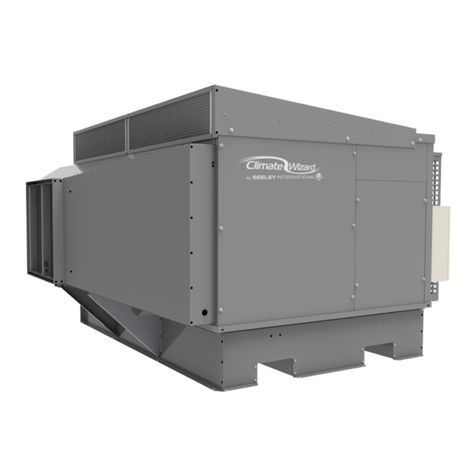
Seeley
Seeley Climate Wizard CW-H10 User manual
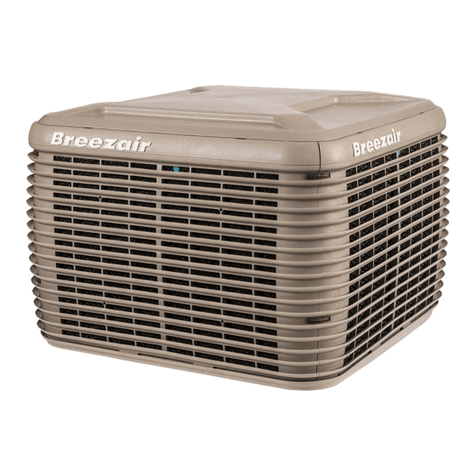
Seeley
Seeley Breezair EXS User manual
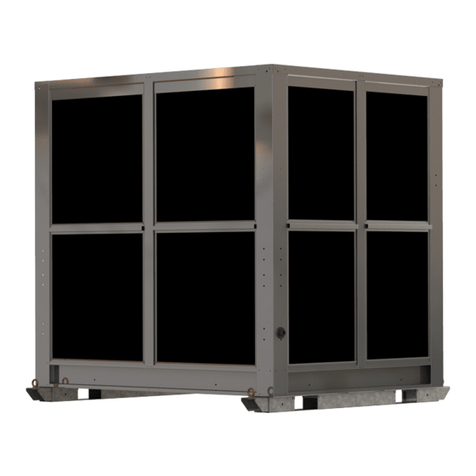
Seeley
Seeley Aira AL Series User manual
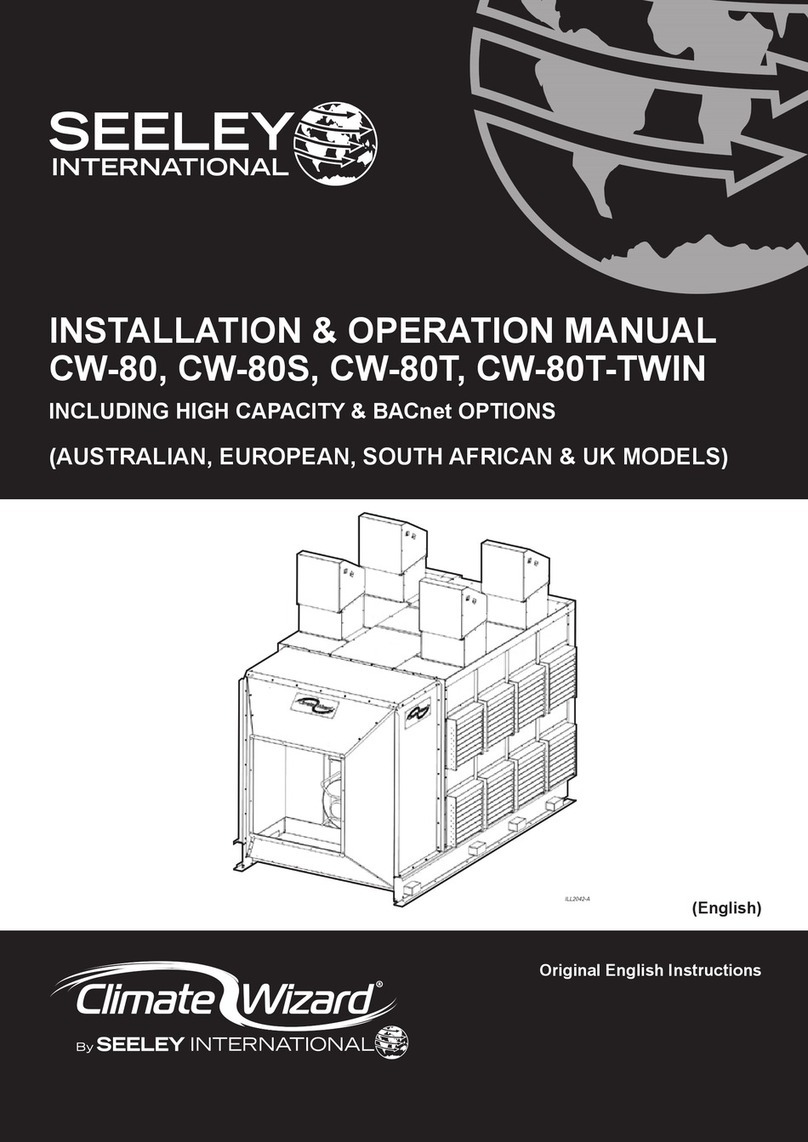
Seeley
Seeley Climate Wizard CW-80 User manual

Seeley
Seeley Convair CTA250 User manual

















